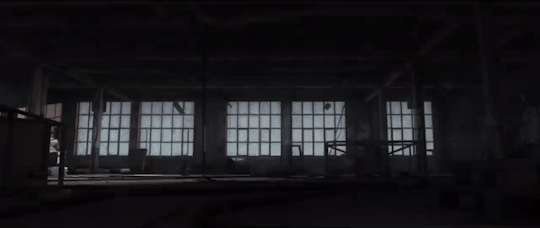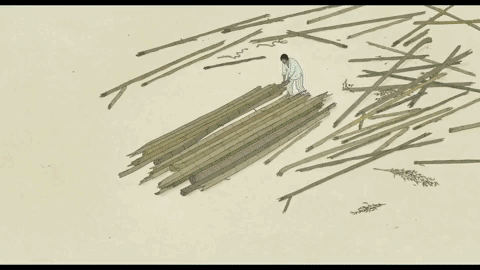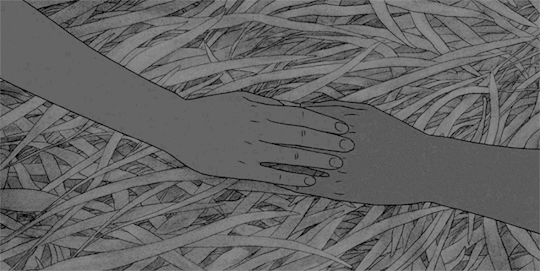originally posted at https://canmom.tumblr.com/post/637765...
or to give it its full title, French magical realist films with an elegant naturalistic cel-shaded drawing style, meditating on themes of guilt and loss, featuring a sequence of a man building an elaborate wooden structure as part of an extended heterosexual romance subplot, but I guess that’s a bit of a mouthful :p
Tonight we are returning to France! We’ve been to France before, when we watched some of Sylvain Chomet’s films (specifically The Old Lady and the Pigeons and The Triplets of Belleville) and the incredible Persepolis, but there’s a lot more going on in France than that!

Tonight I have to main films to show. We have 2019′s J’ai Perdu mon Corps (I Lost My Body), a remarkable film about a severed hand seeking the Moroccan immigrant who lost it, intercut with flashbacks to his story. That film comes closer than anything I’ve seen to the style and tone of Gobelins student films (not surprising given a bunch of their students worked on it), the animation is eye-popping (you will remember this and groan about five minutes in), and it’s no surprise that it’s been sweeping all the big awards (including Annecy!)
Before that, we’re also gonna check out La Tortue Rouge (The Red Turtle), a collaboration between the French studio Wild Bunch and none other than Studio Ghibli. It tells an entirely wordless story of a sailor becoming stranded on an otherwise deserted island, where he meets a strange, bright red turtle who seems determined not to let him leave.

It’s a strange little film - the wordless story, sparse but beautifully textured environments, recurring locations and animals, and the life-spanning, having-a-kid-who-grows-up storyline make it seem like it’s trying to be read as some kind of allegory. But what’s it saying with that? Regardless, it has a ton of beautiful, full-figure animation, and lots of really tasty stuff with textures and little animal animations.
Along with these two films, we’ll be checking out some more of the work of Gobelins students. Gobelins has a pretty towering reputation among animation schools as the place to learn really good, subtle character animation, and is possibly a big part of the reason French animation has become so strong at the moment - hell, I kind of aspire to try getting in there one day if I ever figure out how to fund it! They’ve been steadily releasing this year’s graduation films, so we can get another tasty dose of subtle emotional acting, ambivalent moods, beautiful scenery, etc.

Why I Lost My Body? Well! Let me tell you! It’s not just because it’s a gorgeously animated and moving film, or (as I’m sure @baeddel will be quick to point out!) some kind of guro angle wrt the cute severed hand walking around - it’s also, to my knowledge, the first major film to be animated in Blender’s ‘Grease Pencil’ 2D-in-3D animation tool.
Hold on, let me elaborate. Blender is a flagship open-source project and a powerful full-pipeline 3D editor, but as far as industry adoption has gone, it has suffered from not being able to compete with specialist tools such as ZBrush, along with lacking any hugely compelling reason to break from established general 3D suites like Maya.
This seems to be changing quite suddenly, from an unexpected direction. Over the last few years, Blender has developed a system for drawing 2D strokes - with varying line weight, and a lot of control over rendering style - into a 3D scene. This has a lot of advantages over even established vector animation programs like Adobe Animate or even ToonBoom, because it makes it very easy to plan out a scene in 3D, even animate a character using a simple 3D rig, and then use these layouts and rough animations to guide your drawing.
This is precisely the approach used by I Lost My Body. They’d roughly storyboard the scenes as drawings, animate it using a low-poly 3D mesh, and then draw over the 3D mesh to get back to a drawing style (something 3D programs still can’t do reliably). The result is that they can achieve really precise solid drawing a lot easier, allowing a ton of subtle character acting and creative shots.
This is appealing to me because I’ve been playing with this technique of using 3D blocking-out to plan camera movements… and seeing them get such good results with Grease Pencil is honestly making me think I might be able to drop Krita altogether from the animation part of the process! We’ll see.

On the subject of shots, transitions, etc., this film is unbelievably meticulously storyboarded - to the point it sometimes feels almost too clever. It’s rife with symbolic compositions and visual callbacks and ‘yeah you couldn’t put a camera here in real life but we can’ which makes it a lot of fun to watch, especially the scenes of the hand trying to crawl through the human world without anyone discovering it (or any animals eating it). The hand side could seem like a B plot compared to Naoufel’s arc, but it’s executed with so much flair that you really look forward to those scenes.
Naoufel is a very well-observed character, although not an entirely sympathetic one. As a child, we see him come from a middle-class Moroccan family, eagerly recording the sounds of the world around him… until his parents die in a car crash, leaving him to move into a shithole room in France with distant relatives. Far from becoming a pianist and an astronaut, he ends up a pizza delivery guy, and one day has an extended conversation with a customer which turns into a crush, and then stalking her and getting an apprenticeship with her uncle, hoping to reveal the whole thing in a dramatic romantic gesture. You can probably guess how well that goes.

I get the impression isn’t all that out there a storyline for an arty film. What makes it work for me is both the hand plot that intercuts this and all the other clever shooting tricks, and the fact that the film - while absolutely interested in presenting a detailed, tragic portrait of Naoufel, whose (hand’s) POV it never really leaves - doesn’t seem to be saying he’s right to treat Gabrielle as he does, merely to understand him.
The main limitation of this approach, I feel like, is that the tightly limited POV means we only get snatches of Gabrielle’s side of the story. But then it’s French, and loves to lean on ambiguity. Don’t expect an ending that neatly ties up the whole story, I’ll say in advance!
But honestly? The animation of the hand is what really elevates the film! It’s an adorable little hand creature, sometimes crawling around in a soup can like a hermit crab, leaping and scuttling and sitting but never really coming across as gross. The director comments:
I know that films already exist with a hand, like The Addams Family. But I didn’t want to see a several hand. I wanted to see a new animal, a new character, new behavior – something new coming to life. I had to be careful to not be ‘scary’ with the way the hand walked, i.e. not too much like a spider or the facehugger from Alien. It was really a challenge to also not be too funny, or cute. I wanted something natural, even though it’s not natural to see a hand walking.
At the beginning of the film, we see the birth of the hand. And we show how the hand has to deal with a missing body. Because we see the birth of the hand, it’s like seeing it come to life. The audience is really involved and needs the hand to succeed!
I wanted to allow the hand to have new kinds of positions or unexpected positions. So the hand is able to get on its knees, even if it’s not possible in reality – you can see that in the film when the hand is turning the head to the swan. Even when I say ‘the hand is turning its head,’ it’s crazy to say that! But it’s really what it looks like on the hand.
Also when the hand is going to sit down on the window sill after just escaping from the laboratory, it’s like the hand is resting on the window in a sitting position. Remember, this is despite a hand not being capable of sitting, but we had to make it look like that. It’s like the hand is is trying to find it place in the world and developing its own movement vocabulary.
So look forward to that!

As for the Red Turtle, the background to this film is… ok, so there’s this Dutch animator/director, Michaël Dudok de Wit, who made a very pretty short film called ‘Father and Daughter’. One day, the French auteur-oriented film studio Wild Bunch gets a film from, guess who, Hayao Miyazaki, saying like ‘hey track this guy down, I want Ghibli to make a feature film with him’. Which must have been a hell of a thing for de Wit to hear!
Naturally he said yes to making a film with Ghibli, and various other European studios got roped in. Isao Takahata got involved (rather than Miyazaki) to direct the art, and of all his films, the one I’d compare this most to is The Tale of Princess Kaguya - but we’ll get into his story another time, I gotta save something to write on Isao Takahata night :p

So. What have we got? I’m going to spoil a major happening, so feel free to scroll down a bit… still here? Right. OK, the guy tries to commit a turtle murder (turder), and then gets cold feet and tries to save the turtle. It seems like he’s failed, but then the turtle abruptly transforms into a human woman, who he nurses back to health. They get to fuckin within like… days of meeting, and before long, raise a kid on this island.
As a film about a nuclear family in a survival situation with no other human company, it’s honestly very gentle. The art style is like very few films I’ve seen - not the humans who are realistic except for the ‘two dot and a triangle’ faces, but the way the island itself is drawn. Large fields of foliage have every leaf outlined with very even value, turning it into essentially texture and negative space. The animals bring a lot of character, especially the quartet of crabs whose life we see evolving alongside the humans. Or turtle humans I guess.

Naturally, the child grows up, the sailor grows old… honestly it wouldn’t be too hard to spin this film as ‘a turtle traps a man on an island and uses him as a breeding slave’ if you were so inclined. You could divide the film into two halves, a turtle half and a family half, but they work better together because of the weirdness of the girl being a turtle actually.
Without any dialogue, the animation has a lot to carry, but it’s very much up to the task. At the time it raised questions of rotoscoping, but the method was more like the use of film animation at old Disney works: actors would play out a scene, they would be analysed to draw out their most interesting key poses, and then these poses would be redrawn in the scene. CG was used at two points: the turtle itself, but also the rafts, with the rather startling measure of drawing over every frame of the rafts and re-cel-shading them by hand, not surprisingly exhausting for the animators. The results are convincing though - they raft looks way less out of place than most CG-in-2D.

These films are both beautiful on an animation level, have compelling storylines… and they also thankfully avoid the blithe post-colonial racism that’s weirdly common in French animation. What’s with that! Anyway…
Along with that, I’m putting together a new Gobelins playlist; we’ll mostly be watching their most recent films from this year, but I’ll drop in a few older ones we didn’t get last time around. I’m not sure what it is about Gobelins that makes their films stand out so much compared to other student films - is it larger teams? More input from the instructors on direction? A self-replicating process of people who want to make ‘Gobelins style’ films going to Gobelins? Whatever it is, their tone tends to be pretty recognisable, even while they explore a huge variety of styles with honestly kinda unbelievable technical skill. (I’ll catch up one day you fuckers!)
Here’s an example of one of this year’s Gobelins graduation films featuring work by @cy-lindric as one of the people on here.
Animation Night 32 will start at 7pm UK time (on Thursday 17 December!) as usual, just over three hours from this post! The place will be https://twitch.tv/canmom, and I look forward to sharing these films with you all! ^^
Comments